Article Topics:
- Overview
- Intro to Racing
- Driving Technique
- Practice Sessions
- Driver’s Gear
- Vehicle Safety
- Handling
- Brakes
- Power
- Tools
TurnFast
recommends
these books:
Articles about Driving Techniques
Steering
The steering wheel is where you will get most of your feedback of the track surface from the front tires, suspension, and brakes. As simple as steering may seem to be, for maximum control and smoothness, there are definately some techniques you should be aware of.
Your hands will spend a great deal of time on the steering wheel, so for both sensory input and comfort, how the steering wheel feels in your hand is important. Depending on the size of your hand, you may want a wheel that is thicker or thinner. The exact style, size, and construction is up to you. If you're thinking of changing from the stock steering wheel, choose one that is comfortable gripping the wheel with your driving gloves on.
Steering Wheel Grip
The proper grip of the steering wheel starts with the hands at the 9:00 and 3:00 positions. Contrary to the 10 and 2 o'clock positions you probably learned in driver's school, you have greater range of motion and control with your hands in the 9 and 3 o'clock positions. The palms should be cupping the outer diameter of the wheel, with the thumbs wrapped around the ring and resting on top of the cross brace. The heel of the palm should be positioned to apply a slight pressure on the front of the wheel for stabilizing your arm movements--don't make your thumbs do all the stabilizing. Most stock steering wheels in sports cars, and even sedans, today are properly designed for the 9 and 3 positions with padded thumb detents.
The grip itself should be relaxed--just tight enough to maintain control and good contact for sensory input. A tight grip on the wheel will tire your hands and arms quickly, and more importantly will significantly reduce the sensitivity to the vibrations needed to sense the control limits of the vehicle.
While it is a natural tendency to grip the wheel tightly while corning, no amount of squeezing on that wheel will increase the traction of your tires! However, the more relaxed the grip (without losing contact with the wheel), the more of that traction you will be aware of. It is a learned response to relax your hands (in fact, your entire body) during high g-force cornering, but it is something that you must force yourself to learn as quickly as possible. It will increase your sensitivity to the car's traction limits, and improve your awareness of the car's handling.
Something to practice to ensure your hands, arms and shoulders are relaxed before entering a corner, is to take a deep breath during the straight beforehand. Breath deep, relax your muscles, and exhale. Another thing to do when you're in a long enough straight and clear of other cars, is to relax one hand at a time and wiggle the fingers (leaving the palm and thumb on the wheel). Doing this often will keep the muscles in the hand, wrist, and forearm from cramping.
Steering Wheel Control
When turning a corner, lead into the turn by "pushing" the wheel with the hand opposite the turn (left hand for a right turn), and stabilizing the wheel with the other hand. Push the steering wheel through the 12:00 position rather than pulling it towards the 6:00 position when turning. For large steering inputs like a turn, the pushing arm has more control because the wrist stays in a firm position. The opposite wrist becomes quite bent and will not provide smooth control. "Pulling" the wheel is effective for small steering inputs such as moving across the track width where the action is really limited to a movement of the wrist, and not the whole arm. If you're a puller right now, it will take a little re-training to make this comfortable, but in the long run it will make you a smoother driver.
One of the critical keys to maximizing speed through corners is smooth car control which comes from smooth steering. If the car is to travel on a smooth consistent arc, then the steering input must also be a smooth consistent turn. The purpose of this smoothness is to maximize the traction of the tires. To understand this, take a sheet of paper, place it on a table, and place a book on the paper. Pull the paper slowly across the table gradually increasing the speed. The book stays on the paper. Now, start to drag the paper again, but at some point suddenly jerk the paper. The book loses traction and slides across the paper. We'll talk more about the tire's perspective of this later, but for now the motion of dragging the paper is like your steering input. The traction of the tire is significantly influenced by your ability to provide smooth turning. Sudden jerks in the wheel will be like sudden jerks on the paper, and the tire will slide. The smoother driver will have more traction, and will have higher corner speeds.
It is common to think you are turning smoothly, when in fact you are turning on a smaller, tighter, and jerkier radius than you need to. In car video can be a great help to wtaching yourself, and recognizing where you need to be smoother. A typical tip off to a driver that needs to be smoother is when a car tends to understeer during the first half of a turn. More often than not this is caused by the driver's lack of steering smoothness than by car setup problems.
Read Next Article (Shifting)
Tags: Race Seats, Racing Steering Wheels, Competition Seat Belts
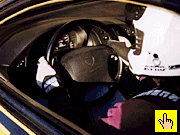
The proper hand positions are 3:00 and 9:00 with the thumbs wrapped around the ring resting on the crossbrace, the palms cupping the outer diameter of the ring, and the heels of the palm applying a light pressure to the front of the wheel. The grip should be relaxed--just tight enough for control and good sensory input.
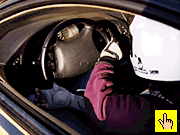
Most corners can be driven through without moving the hands from the 3 and 9 positions in a sports car. This allows your arms a little more than 180 degrees of wheel turn. Note in this photo that the thumb of the right hand is kept under the crossbrace of the wheel. This provides extra stability.
If a corner requires a little more steering input than 180 degress, the following technique provides the most control. This should get the car through even slow, tight, 90 degree turns. Let's look at a right turn for the example.
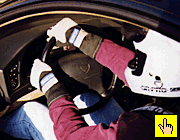
Just before the turn-in point, relax the grip on the right hand and slide it along the wheel to the 11:00 position (don't take your hand off the wheel). This places both hands close together at the start of the turn.
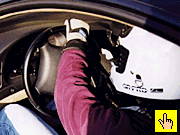
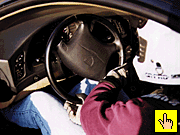
Keep both hands close together, and progress through the turn. This hand position allows about 260 degrees of steering wheel movement placing the right hand about 6:00.
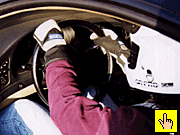

When unwinding from this position, leave both hands tight on the wheel until the right hand reaches 9:00. Relax the right hand grip slightly, finish leading the unwind with the left hand, and allow the wheel to slide through the right hand.
For hairpins, or switch-back corners, you will likely need to use a hand over hand action. Some drivers like to start a large steering input like this by placing the leading hand at the 6:00 position, and turning a full 360 degrees before involving the other hand. This seems to simply the action, but it has the drawback of having only one hand on the wheel for quite a while. The control is not likely to be as smooth, the sensory input is halved, and in a racing situation in traffic, the ability to maintain control if bumped is reduced. Smaller, repetiive hand moves in a hand over hand situation is better.
